The Cruiser tank lineage
The Cruiser tank family started in 1936, when Vickers proposed to the War Office a new medium tank, cheap, using a commercial petrol engine, the A9E1. It was also an interim model before the Christie suspensions could be produced. 125 were ordered and delivered as the Tank, Cruiser Mk.I. It proved very effective, especially in the early part of the war in Libya. It was replaced by the Mk.II (A10), as an improvement of the latter, heavier and better protected, with 175 units built in 1939. But the real game changer was the Cruiser, Mark III, featuring the Christie suspension, coupled with a more powerful engine, which allowed greater speeds, especially on a flat terrain, like the North African landscape. It was built by Nuffield Mechanisations & Aero, Limited. 65 were built in 1939, replaced by the successful Cruiser Mk.IV (890) and Mk.IVA built by Nuffield, Leyland, English Electric and LMS.Concurrent with the Mark V Covenanter
The Cruiser Mark V was better known as the "Covenanter" or, officially, the A13 Mk.III. After it, all Cruiser names started with a "C". It was basically a better armored and designed version of the previous MK.IV, featuring a new hull, improved Christie style suspensions, a Meadows DAV flat-12 giving 340 bhp and Meadows gearbox with Wilson epicyclic steering. Above all, it hadbetter overall protection, with increased armor thickness and a new turret design, very low, sloped and angular, built by Nuffield, which became a characteristic of the following tanks. Despite all these improvements, the Covenanter design incorporated a major flaw in engine ventilation. Consequently, it was never deployed in the desert, but served in the British Isles until 1943, as a training tank and in home defense regiments. Nuffield Company, which took part in the project, already worked on a modified A13 of its own.Conception of the A15
The ventilation problems appeared when the production of the Covenanter was already well advanced. The Nuffield chief engineer had already devised, on the drawing board, a new, parallel design for the A13, around a home-built V12, the Liberty Mark I. This model, combined with a longer hull, and a hull with Christie suspensions, was ordered by the general staff under the specification A15. Working day and night, the team delivered its first prototype six weeks before the Covenanter.It was a heavier, at nearly 20 tons compared to the 15-16 of the other "Christie cruisers", distributed on five road wheels instead of four. The double hull was almost unarmored, housing the large suspension arms. The longer hull could accommodate the usual famous sloped design turret, and a secondary one forward left, equipped with a Besa 7.9 mm (0.31 in) machine-gun. Another coaxial one was mounted on the right side of the gun.
The Nuffield V12 Mk.II engine, retained for production, provided adequate torque for the weight it had to carry, providing a 17 bhp per ton ratio. It was alimented by three enormous 110 imperial gallons fuel tanks and an auxiliary, rear exterior one, fed by gravity. Besides the good speed which could be achieved, the range was also adequate for the huge distances of desert warfare. Transmission was assured by a Nuffield constant mesh 4-speed-and-reverse and steering by a Wilson epicyclic system.
The hull was narrow and cramped, with a large space taken by ammunition. There were a commander and gunner, both in the main turret, a loader, a driver, and a secondary gunner manning the forward hand-traversed turret. Because of the crowded interior, and dubious effectiveness in combat of the secondary turret, the latter was often dismounted in practice, and suppressed in the next Crusader Mark II.
Crusader Mark I
The Mark I was quickly put in production after the prototype was tested, in mid-1940. None was ready for the campaign of France however, but they were quickly shipped in Egypt and took part in the first phase of the war against the invading Italian forces. The Mark I of early production had a "semi-internal" cast gun mantlet, which was replaced on the late models by a bigger cast mantlet with three vertical slits, for the gun, machine-gun and periscope. The large sloped turret, also designed for maximum internal space, had no cupola, but a flat hatch with the periscope mounted inside. In practice, it was open most of the time. The gun was balanced through a paddle shaft, making pointing easier and more accurate, and allowing efficient fire on the move. On the very flat terrain encountered in the Libyan plains, this feature was of great proficiency.The 40 mm (1.57 in) armor was designed to deal with most tanks of the time (in 1939), armed with 37 mm (1.46 in) guns. The frontal glacis was sloped, like the turret, but the rear and sides were flat and more vulnerable. Early production models were given provisional armored side panels, usually protecting the rear part of the tank (engine and fuel tanks). The first unit to fight with these brand-new Crusaders Mark I was the 6th Royal Tank Regiment, part of the 7th Armoured Brigade. They fought alongside Matilda infantry tanks, using their speed for screening tactics. No Italian tank was a threat, but this would change with the arrival of Rommel and his Panzer IIIs in Africa, in January 1941.
Crusader Mark II
Late production Mark Is were given large side protective panels, attached to the upper hull, providing better protection against the 50 mm (1.97 in) gun of the Panzer III and Pak-40 AT gun. These panels became permanently attached from the factory starting from the Mark II. This new version also received a large increase in armor, from 40 to 49 mm (1.57-1.93 in), on the frontal glacis and turret. The added weight was coped with by a more powerful Nuffield Liberty Mk.III. To save weight and a crew member, the awkward turret was often removed. The only machine-gun that remained was the coaxial one. The large "three slit" cast mantlet was also serial. This evolution arrived in 1942, just in time for some major battles of the campaign of Africa. Some were converted on the stocks as infantry support tanks, or CS (Close Support), equipped with a 3 in (76.2 mm) howitzer launching smoke grenades.If the Mark I and II turned to be effective in Libya against Italians, it was another affair against the "Desert Fox". While its speed, light protection and armament could deal with most German Panzer I and IIs, the Panzer III, equipped with the long barrel 50 mm (1.97 in) gun, and the Panzer IV and its 75 mm (2.95 in), were more than a match. Plus, German tactics, using a feint retreat under the cover of well-placed AT guns, including the fearful 88 mm (3.46 in), proved deadly effective. The Crusaders at Gazala and around Tobrouk, forming the biggest part of the British armored forces in Africa, had few options but to retreat or try to outrun the well-concealed German gunners.
There were also severe limitations from the tank itself. Starting with poor handling in African ports, repairs, premature use of their train and tracks because of the lack of transportation infrastructure, and then conception problems in the field. For example the lower part of its angled turret acted like a lever at each shell impact, dislodging the turret from its mounting, or a hull vulnerable spot above the ammunition racks, where, if red hot metal fragments penetrated, they triggered a fire. There were also issues with the engine overheating, oil leaking, and problems with the cooling filter system, mostly caused of sand erosion.
Crusader Mark III: first to bear the six-pounder
Prior to the climactic battle of El Alamein, most Crusaders had been retired from regular frontline units, replaced by much more effective M3 Lee/Grant medium tanks. The move was even accelerated when the first M4 Shermans arrived en masse. The Crusaders were relegated, with M3 Stuarts, to screening and scouting forces, to exploit breakthroughs, or relegated to secondary sectors. However, when the need for a new heavy cruiser tank, expressed since 1940, appeared compromised, a stopgap measure was taken in March 1941.There were trials to adapt the very effective 6-pdr (57 mm/2.24 in) AT gun to a tank turret, and finally the Crusader was chosen. This was the first time this already well-proven gun was mounted on a tank. This led to a complete redesign of the interior, a new increase in frontal armor (now 51 mm/2 in), no more auxiliary turret, better protection for the turret mounting and around the ammunition racks, and some improvements to the ventilation system. The crowded turret, equipped with exhaust vents for the gun fumes also dictated a drastic reduction of crew (now three, the commander was also the loader).
The Mark III was now propelled by the Liberty Mk.IV, latest evolution of Nuffield V12. The new gun, with 50 rounds (against 110 for the previous 2-pdr), was provided with some AP rounds, and had a far better punch against existing Axis tanks, notably Panzer III and IV. The Mark III replaced all existing versions and was largely produced, form early 1942 to mid-1943. But, by then, the Crusader was seen increasingly as obsolete, being already replaced by more capable Cavalier, Centaur and Cromwell tanks, the new long-awaited generation of "cruisers". Despite of this, they played their part in the second battle battle of El Alamein. Their great speed could still be exploited in some occasions.
Many were equipped with a Anti-Mine Roller Attachment (AMRA) kit, to deal with the huge German minefields, during the first hours of the offensive. Crusaders (almost only Mark IIIs) were still seen in action in Tunisia by 1943, Sicily, and Italy. But by mid-1944, many were converted on the stocks, or remained in home defense units, and were used for tactical drilling until 1945. The Mark III remains the biggest production of the entire Cruiser VI series.
Main variants
Besides limited numbers of CS (Close Support) infantry tanks, equipped with 76 mm (3 in) howitzers, based on regular Mark I and II, there were also command tanks, equipped with a dummy gun and two powerful No.19 radios. Many Mark IIIs were modified prior to the battle of El Alamein as artillery observation mobile posts. Modifications included a fixed turret, dummy gun, a No.18 and No.19 radios and a broader, emptied interior filled with maps boards and equipment. Many retired or half-cannibalized Mark I/IIs also served for deception plans, notably at El Alamein, and later in southern England, during operation "Fortitude".Crusader III AA: many surviving Crusader IIIs were converted as auxiliary mobile AA batteries, equipped with a 40 mm (1.57 in) QF Bofors mounted in a turret-like shield. Mark II and Mark III AA variants featured a twin (and later a rare triple) Oerlikon 20 mm (0.79 in) mount, coupled with a targeting .303 (7.7 mm) Vickers GO machine-gun. Few of them saw action in Europe, as Allied air superiority proved sufficient. They served mostly as mobile local defense posts, around airfields, ammunition storage facilities, HQs, etc.
Crusader II Gun Tractor: Retired Mark IIs were often converted as gun tractors, for towing the effective but heavy QF 17-pdr (76.2 mm/3 in) AT gun. Their superstructure was removed and replaced by a large, boxy one, with 14 mm (0.55 in) thick plates and a crew of six. Speed was still relatively good (27 mph/43 km/h). They were fielded for D-Day operations, and many remained in service until the end of the war, sometimes being used as command tanks, scouts and artillery observation vehicles.
Operators
Commonwealth tank crews were soon equipped with Crusaders, by 1941. This includes South Africans, New Zealanders and Australians. Other nationalities were also equipped in increasing quantities, as the Crusaders were replaced in British service, like some Free French and Dutch units. Some Mark I and IIs were captured by the Axis during Rommel\'s advance, and both the Littorio armored division and German 15th Panzer division used many captured models to compensate for their own losses. They appreciated their speed and relatively low profile in operations, but were limited by the lack of spare parts. The Canadians, fighting in Italy, were also provided Crusader IIIs for their cavalry units. After the war, many were sold to the Argentinians, who converted them as motorized gun carriage, equipped with modern 75 and 105 mm (2.95 and 4.13 in) guns.Succession and heritage
The Crusader, and especially the Mark III, was considered as a stopgap before the arrival of heavier Cruisers, which were currently in developments and trials. All would have to be equipped with the AT 6-pdr (57 mm/2.24 in). The mid-1940 specification of the Directorate of Tanks and Transport targeted three companies: Vauxhall, producing the Churchill tank, and both Nuffield and the Birmingham Railway Carriage and Wagon Company, producing the Crusader. The Nuffield designers produced, in a rush, an upgraded Crusader, the A24 Cavalier, also called later Cromwell I. The Cavalier was quickly approved by the army and developed in such a haste, with existing components, and the Crusader Nuffield Liberty engine, that many problems quickly occurred in the field. But with added armor and equipment, a larger hull, it showed poor performances and of the original order, only 500 were built. The development of a heavy cruiser tank led to the Rolls-Royce Meteor powered Cromwell tank, in 1943, alongside the Centaur. The Cromwell, in turn, led to the development of the Comet, which itself was influential in the design of the most successful British tank of the cold war, the legendary Centurion main battle tank.Crusader specifications |
|
| Dimensions | 19.6 x 9.1 x 7.35 ft (5.97 x 2.77 x 2.24 m) |
| Total weight, battle ready | 18.8-19.7 tons |
| Crew | 4/5/3 (Mk.I/II/III) |
| Propulsion | Nuffield Liberty Mk.II/III/V V12 27L petrol, 340 bhp@1500 rpm |
| Speed | 26 mph (42 km/h) onroad
19 mph (30.5 km/h) off-road |
| Range (off-road/road) | 146/200 mi (235/322 km) |
| Armament | Main: QF 2pdr (40 mm/1.57 in)
QF 6pdr (57 mm/2.24 in) Mk.III 1/2 Besa machine-guns, 5950 rounds |
| Maximum armor (Mk.I/II/III) | 40/49/51 mm (1.57/1.93/2 in) |
| Total production | 5300 from 1940 to 1943 |
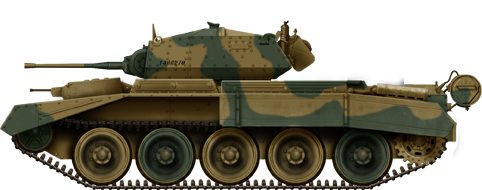
An early production Mk.I, Libya, Operation Crusader, November 1941.

A Crusader Mk.I CS (Close Support). These converted versions were equipped with a 3.7 in (94 mm) L15 howitzer firing smoke rounds. Gazala, December 1941.
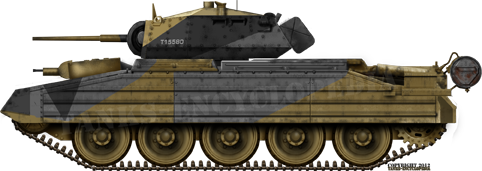
Late Crusader Mk.I. These models incorporated modifications gained from early desert war experience, like a slightly better ventilation system, to try to prevent the engine of overheating, and better, full side, fixed protective panels.
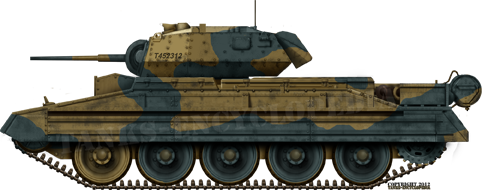
A Crusader II of the 9th Queen Lancers, attached to the 1st Division, Libya, December 1941. Besides new protective panels and some minor alterations, the Mark II were pretty close to the previous Mark I. They even retained the auxiliary forward turret, usually removed soon after arrival on the front.
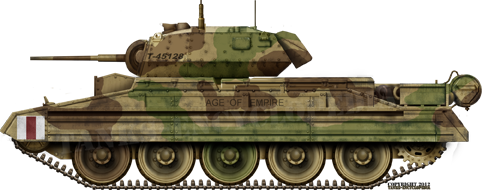
A Cruiser VI "Crusader" Mark II of the 22nd armoured brigade in Libya, december 1941. This three-tone pattern was rare.
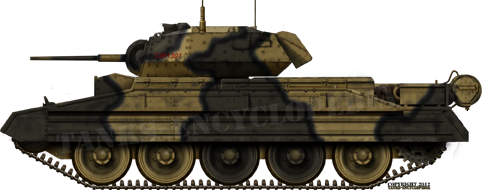
Late production Crusader Mk.II. Unknown unit, Gazala, May 1942. By the beginning of the second battle of El Alamein, almost all Mark I and IIs had been removed from the frontline, replaced by more recent Mark IIIs.
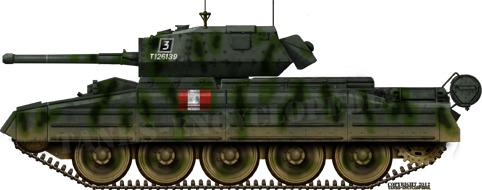
Crusader Mark III from the 6th Armoured Division, February 1943, showing a green pattern with dark green, blended stripes. Crusaders were often painted "on the spot" with available colors and depending on the season and landscape, as there were few regulations on this matter.
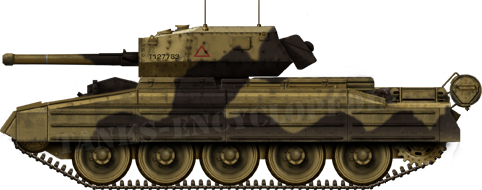
A Crusader Mark III, one of the only 100 which fought in October 1942 during the second battle of El Alamein.
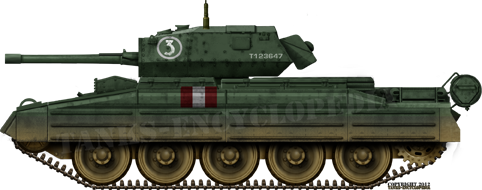
Cruiser VI Crusader III of the 17th/21st Lancers, 6th Armored Division, Tunisia, November 1943.
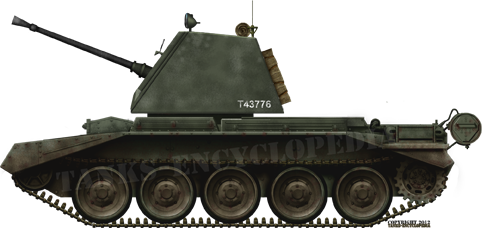
Over 1373 Crusaders were converted for special purposes, of which around 400 were Crusader AA Mark Is. It was armed with a Bofors 40 mm (1.57 in), bringing its highly recognizable "pom-pom" sound on the battlefield, which gave it its popular surname among soldiers and Royal Navy sailors as well. This was the first conversion of existing Mk.III hulls. At first, the gun was just mounted on an open platform with its regular front flat shield. But it soon became obvious that better protection was needed and a four-side, open-top shield was wrapped around, for the next batch of late production models.
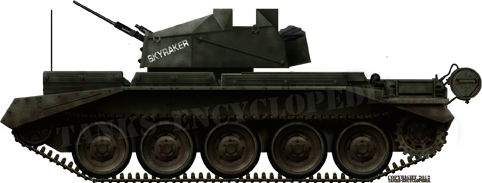
A Crusader AA Mark III, with its distinctive twin 20 mm (0.79 in) Oerlikon mount. It had a devastating combination of speed and firepower, especially deadly for low-flying aircraft. They were coupled with a targeting .303 (7.7 mm) Vickers machine gun. These guns were balanced by a large metal cylinder mounted on a threaded rod, for adjustment. They could fire almost vertically. Mark II and III only differed by the radio position, moved from the turret into the hull, for added free space. They were put in use in the later stages of the African campaign, in Tunisia, and fought in Sicily, Italy and Normandy. There, Allied air dominance was such that they were relegated to secondary duties. Production records are scarce but, in June 1944, 268 of these Mk.II/III were enlisted for D-Day. First tests began in June 1943, and conversions started in October. Normal provision was 600 rounds.
Crusader gallery

A Crusader Mk.II in Libya, October 1942 - Credits: Imperial war museum





WW2 Tanks




























WW2 tanks posters

All Tiger tanks liveries.

Panther liveries and variants

WW2 Armour - All tanks











Tanks aces and single tanks series

Find more there

Museums, Movies, Books & Games
The Tanks and Armor in pop culture
Tanks and armored vehicles in general are only really grasped when seen first person: The mass, the scale, it's all there. Explore also the way tanks were covered in the movie industry, in books and in video games.Movies:
Best tanks movie on warhistoryonline.com
On imdb.com
On bestsimilar.com/
miltours.com
liveabout.com/
watchmojo.com
Video Games:
pcgamesn.com
historyhit.com
levvvel.com
vg247.com/best-tank-games
mmobomb.com/
alienwarearena.com

